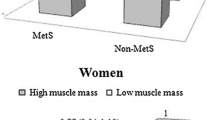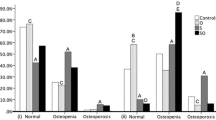Abstract
To evaluate the relationship between skeletal muscle mass and bone mineral density (BMD) and to determine the association between low skeletal muscle mass and low BMD in urban dwelling young adults. This study was based on data from the 2008–2011 Korea National Health and Nutrition Examination Surveys. The subjects were 1702 20–49-year-old men and 2192 premenopausal women (age 20–55 years). BMD at the lumbar spine, femoral neck, and total hip and the appendicular skeletal muscle mass (ASM) were measured by dual-energy X-ray absorptiometry. Skeletal muscle mass index (SMI) was defined as weight-adjusted ASM. Mildly and severely low muscle skeletal mass were defined as SMI that was 1–2 and >2 standard deviations below the sex-specific mean ASM of young adults, respectively. Low BMD was defined as T score of less than −1.0 at the lumbar spine, femoral neck, and/or total hip. After adjusting for confounders, skeletal muscle mass was positively associated with BMD at the lumbar spine, femoral neck, and total hip in both men and women. Mildly and severely low skeletal muscle mass increased the risk of low BMD in premenopausal women [OR (95% CI) = 1.4 (1.1–1.9) and 2.4 (1.2–4.6), respectively] but not men. In women, low skeletal muscle mass independently was associated with the risk of low BMD at the femoral neck and total hip but not the lumbar spine. Skeletal muscle mass was independently associated with BMD in urban dwelling young men and women, but low skeletal muscle mass was associated with the risk of low BMD in premenopausal women only.

Similar content being viewed by others
Abbreviations
- 25OHD:
-
25-Hydroxyvitamin D
- ALT:
-
Alanine aminotransferase
- ASM:
-
Appendicular skeletal muscle mass
- AST:
-
Aspartate aminotransferase
- BMD:
-
Bone mineral density
- BMI:
-
Body mass index
- DXA:
-
Dual-energy X-ray absorptiometry
- KNHANES:
-
Korea National Health and Nutrition Examination Surveys
- LBM:
-
Lean body mass
- SD:
-
Standard deviation
- SMI:
-
Skeletal muscle mass index
References
Watts NB, Manson JE (2017) Osteoporosis and fracture risk evaluation and management: shared decision making in clinical practice. JAMA 317(3):253–254. doi:10.1001/jama.2016.19087
Black DM, Rosen CJ (2016) Clinical practice. Postmenopausal osteoporosis. N Engl J Med 374(3):254–262. doi:10.1056/NEJMcp1513724
Giusti A, Bianchi G (2014) Male osteoporosis. Reumatismo 66(2):136–143. doi:10.4081/reumatismo.2014.786
McLendon AN, Woodis CB (2014) A review of osteoporosis management in younger premenopausal women. Womens Health (Lond) 10(1):59–77. doi:10.2217/whe.13.73
Vondracek SF, Hansen LB, McDermott MT (2009) Osteoporosis risk in premenopausal women. Pharmacotherapy 29(3):305–317. doi:10.1592/phco.29.3.305
Mounach A, Abayi DA, Ghazi M, Ghozlani I, Nouijai A, Achemlal L, Bezza A, El Maghraoui A (2009) Discordance between hip and spine bone mineral density measurement using DXA: prevalence and risk factors. Semin Arthritis Rheum 38(6):467–471. doi:10.1016/j.semarthrit.2008.04.001
Cui LH, Shin MH, Kweon SS, Park KS, Lee YH, Chung EK, Nam HS, Choi JS (2007) Relative contribution of body composition to bone mineral density at different sites in men and women of South Korea. J Bone Miner Metab 25(3):165–171. doi:10.1007/s00774-006-0747-3
Taaffe DR, Cauley JA, Danielson M, Nevitt MC, Lang TF, Bauer DC, Harris TB (2001) Race and sex effects on the association between muscle strength, soft tissue, and bone mineral density in healthy elders: the Health, Aging, and Body Composition Study. J Bone Miner Res 16(7):1343–1352. doi:10.1359/jbmr.2001.16.7.1343
Ahn SH, Lee SH, Kim H, Kim BJ, Koh JM (2014) Different relationships between body compositions and bone mineral density according to gender and age in Korean populations (KNHANES 2008–2010). J Clin Endocrinol Metab 99(10):3811–3820. doi:10.1210/jc.2014-1564
Makovey J, Naganathan V, Sambrook P (2005) Gender differences in relationships between body composition components, their distribution and bone mineral density: a cross-sectional opposite sex twin study. Osteoporos Int 16(12):1495–1505. doi:10.1007/s00198-005-1841-4
Schoenau E, Neu CM, Beck B, Manz F, Rauch F (2002) Bone mineral content per muscle cross-sectional area as an index of the functional muscle-bone unit. J Bone Miner Res 17(6):1095–1101. doi:10.1359/jbmr.2002.17.6.1095
Kirchengast S, Huber J (2012) Sex-specific associations between soft tissue body composition and bone mineral density among older adults. Ann Hum Biol 39(3):206–213. doi:10.3109/03014460.2012.676067
Genaro PS, Pereira GA, Pinheiro MM, Szejnfeld VL, Martini LA (2010) Influence of body composition on bone mass in postmenopausal osteoporotic women. Arch Gerontol Geriatr 51(3):295–298. doi:10.1016/j.archger.2009.12.006
Blain H, Vuillemin A, Teissier A, Hanesse B, Guillemin F, Jeandel C (2001) Influence of muscle strength and body weight and composition on regional bone mineral density in healthy women aged 60 years and over. Gerontology 47(4):207–212
Pluijm SM, Visser M, Smit JH, Popp-Snijders C, Roos JC, Lips P (2001) Determinants of bone mineral density in older men and women: body composition as mediator. J Bone Miner Res 16(11):2142–2151. doi:10.1359/jbmr.2001.16.11.2142
Korea Centers for Disease Control and Prevention. The Fourth and Fifth Korea National Health and Nutrition Examination Survey (KNHANES IV, V) 2008–2011. Seoul, Korea: Division of Chronic Disease Surveillance, Korea Centers for Disease Control and Prevention
Heymsfield SB, Smith R, Aulet M, Bensen B, Lichtman S, Wang J, Pierson RN Jr (1990) Appendicular skeletal muscle mass: measurement by dual-photon absorptiometry. Am J Clin Nutr 52(2):214–218
Janssen I, Heymsfield SB, Ross R (2002) Low relative skeletal muscle mass (sarcopenia) in older persons is associated with functional impairment and physical disability. J Am Geriatr Soc 50(5):889–896
Kim BJ, Ahn SH, Kim HM, Lee SH, Koh JM (2015) Low skeletal muscle mass associates with low femoral neck strength, especially in older Korean women: the Fourth Korea National Health and Nutrition Examination Survey (KNHANES IV). Osteoporos Int 26(2):737–747. doi:10.1007/s00198-014-2959-z
Baumgartner RN, Koehler KM, Gallagher D, Romero L, Heymsfield SB, Ross RR, Garry PJ, Lindeman RD (1998) Epidemiology of sarcopenia among the elderly in New Mexico. Am J Epidemiol 147(8):755–763
Cawthon PM, Peters KW, Shardell MD, McLean RR, Dam TT, Kenny AM, Fragala MS, Harris TB, Kiel DP, Guralnik JM, Ferrucci L, Kritchevsky SB, Vassileva MT, Studenski SA, Alley DE (2014) Cutpoints for low appendicular lean mass that identify older adults with clinically significant weakness. J Gerontol A Biol Sci Med Sci 69(5):567–575. doi:10.1093/gerona/glu023
Wolfe RR (2006) The underappreciated role of muscle in health and disease. Am J Clin Nutr 84(3):475–482
Moon SS (2014) Relationship of lean body mass with bone mass and bone mineral density in the general Korean population. Endocrine 47(1):234–243. doi:10.1007/s12020-013-0160-3
Sornay-Rendu E, Duboeuf F, Boutroy S, Chapurlat RD (2016) Muscle mass is associated with incident fracture in postmenopausal women: the OFELY study. Bone. doi:10.1016/j.bone.2016.10.024
Hars M, Biver E, Chevalley T, Herrmann F, Rizzoli R, Ferrari S, Trombetti A (2016) Low lean mass predicts incident fractures independently from FRAX: a prospective cohort study of recent retirees. J Bone Miner Res 31(11):2048–2056. doi:10.1002/jbmr.2878
Frost HM (2003) Bone’s mechanostat: a 2003 update. Anat Rec A 275(2):1081–1101. doi:10.1002/ar.a.10119
Le Bihan MC, Bigot A, Jensen SS, Dennis JL, Rogowska-Wrzesinska A, Laine J, Gache V, Furling D, Jensen ON, Voit T, Mouly V, Coulton GR, Butler-Browne G (2012) In-depth analysis of the secretome identifies three major independent secretory pathways in differentiating human myoblasts. J Proteom 77:344–356. doi:10.1016/j.jprot.2012.09.008
Sievanen H (2005) Hormonal influences on the muscle-bone feedback system: a perspective. J Musculoskelet Neuronal Interact 5(3):255–261
DiGirolamo DJ, Kiel DP, Esser KA (2013) Bone and skeletal muscle: neighbors with close ties. J Bone Miner Res 28(7):1509–1518. doi:10.1002/jbmr.1969
MacDougall JD, Gibala MJ, Tarnopolsky MA, MacDonald JR, Interisano SA, Yarasheski KE (1995) The time course for elevated muscle protein synthesis following heavy resistance exercise. Can J Appl Physiol 20(4):480–486
Dreyer HC, Fujita S, Cadenas JG, Chinkes DL, Volpi E, Rasmussen BB (2006) Resistance exercise increases AMPK activity and reduces 4E-BP1 phosphorylation and protein synthesis in human skeletal muscle. J Physiol 576(Pt 2):613–624. doi:10.1113/jphysiol.2006.113175
Suominen H (2006) Muscle training for bone strength. Aging Clin Exp Res 18(2):85–93
Ashby RL, Adams JE, Roberts SA, Mughal MZ, Ward KA (2011) The muscle-bone unit of peripheral and central skeletal sites in children and young adults. Osteoporos Int 22(1):121–132. doi:10.1007/s00198-010-1216-3
Wu F, Callisaya M, Wills K, Laslett LL, Jones G, Winzenberg T (2017) Both baseline and change in lower limb muscle strength in younger women are independent predictors of balance in middle-age: a 12-year population-based prospective study. J Bone Miner Res. doi:10.1002/jbmr.3103
Acknowledgements
This work was supported by the Basic Science Research Program through the National Research Foundation of Korea (NRF), which was funded by the Ministry of Science, ICT & Future Planning (NRF-2014R1A1A1006695).
Author information
Authors and Affiliations
Corresponding author
Ethics declarations
Conflict of interest
In Je Kim and Kwi Young Kang have no competing interests to declare.
Human and Animal Rights and Informed Consent
All participants gave informed consent before being included in this study. This study did not need ethical approval of our Institutional Review Board, since the survey data examined were publicly available.
Electronic supplementary material
Below is the link to the electronic supplementary material.
Rights and permissions
About this article
Cite this article
Kim, I.J., Kang, K.Y. Low Skeletal Muscle Mass is Associated with the Risk of Low Bone Mineral Density in Urban Dwelling Premenopausal Women. Calcif Tissue Int 101, 581–592 (2017). https://doi.org/10.1007/s00223-017-0314-z
Received:
Accepted:
Published:
Issue Date:
DOI: https://doi.org/10.1007/s00223-017-0314-z




